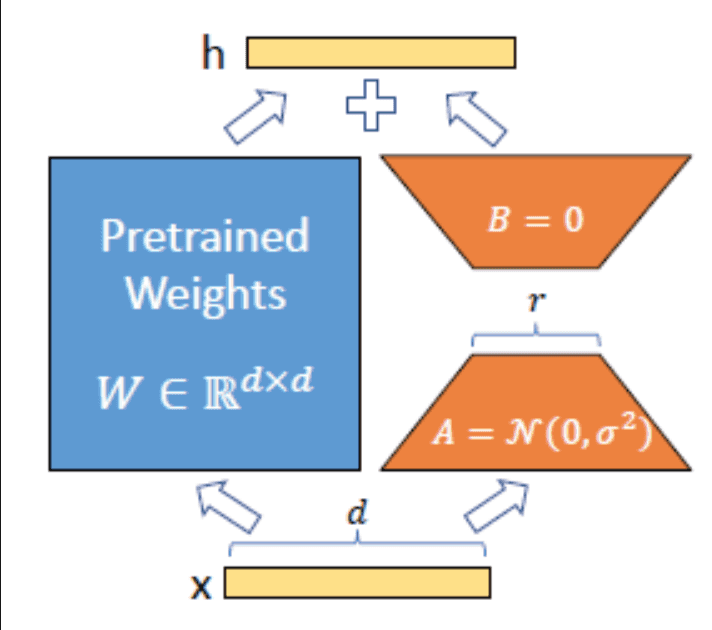LoRAMBo: Fighting LoRA Memory Bottlenecks Through Optimized Rank Selection 🧠



Introduction 🎯
Low-Rank Adaptation (LoRA) has emerged as a powerful technique for efficient fine-tuning of large language models. However, determining the optimal allocation of low-rank parameters across model layers remains a significant challenge. This research presents a comprehensive theoretical framework for optimizing rank selection in LoRA, leading to improved memory efficiency without compromising model performance.
Key Innovations 💡
Our work unifies multiple theoretical perspectives to create a robust framework for LoRA rank selection:
-
Classical Matrix Approximation: We leverage the Eckart-Young-Mirsky theorem to establish fundamental error bounds for low-rank approximations.
-
Curvature-Aware Allocation: We introduce Hessian-based sensitivity measures to ground "layer importance" in second-order optimization theory.
-
Data-Dependent Optimization: Novel data-weighted norms provide tighter approximation bounds when the data manifold resides in a low-rank subspace.
-
Adaptive Online Algorithm: We develop an iterative rank-allocation strategy with proven near-optimality guarantees.
Theoretical Framework 📚
Matrix Approximation Foundations
At the core of LoRA lies the weight update equation:
def lora_update(W, A, B):
"""
W: Original weight matrix (d × k)
A: Low-rank factor (d × r)
B: Low-rank factor (r × k)
r: Rank of the update (r << min(d,k))
"""
return W + torch.matmul(A, B)The optimal rank allocation follows our derived formula:
def optimal_rank_allocation(layer_sensitivity, dim_d, dim_k, total_budget):
"""Calculate optimal rank for each layer based on sensitivity and dimensions"""
r_i = (total_budget / L) * (
(layer_sensitivity**0.5 * (dim_d + dim_k)**-0.5) /
sum(s**0.5 * (d + k)**-0.5 for s, d, k in layer_params)
)
return int(round(r_i))Hessian-Based Sensitivity Analysis
We compute layer sensitivity using Hessian approximations:
def compute_hessian_sensitivity(layer, data_batch):
"""Estimate layer sensitivity via Hessian trace approximation"""
def hvp(v): # Hessian-vector product
grad = torch.autograd.grad(loss, layer.parameters(), create_graph=True)
return torch.autograd.grad(sum((g * v).sum() for g in grad),
layer.parameters())
# Power iteration to approximate largest eigenvalue
v = torch.randn_like(layer.weight)
for _ in range(num_power_iterations):
v = hvp(v)[0]
v = v / v.norm()
return v.norm() # Approximates Tr(H) or ||H||_opImplementation Details 🔧
Online Rank Allocation Algorithm
Our adaptive rank selection process:
class LoRAMBoOptimizer:
def __init__(self, model, total_budget):
self.model = model
self.budget = total_budget
self.current_ranks = {l: 0 for l in model.layers}
def update_ranks(self, loss_improvement_threshold=1e-4):
"""Iteratively allocate ranks to layers with highest benefit"""
while self.used_budget < self.budget:
benefits = []
for layer in self.model.layers:
if self.can_increment_rank(layer):
delta = self.estimate_improvement(layer)
benefits.append((delta, layer))
if not benefits or max(b[0] for b in benefits) < loss_improvement_threshold:
break
best_layer = max(benefits, key=lambda x: x[0])[1]
self.increment_rank(best_layer)Efficient Memory Management
Key techniques for reducing memory overhead:
def create_efficient_lora_layer(base_layer, rank, alpha=32):
"""Creates memory-efficient LoRA layer with dynamic scaling"""
lora_A = nn.Parameter(torch.zeros(base_layer.in_features, rank))
lora_B = nn.Parameter(torch.zeros(rank, base_layer.out_features))
# Initialize using scaled random normal initialization
nn.init.normal_(lora_A, std=1.0 / rank)
nn.init.zeros_(lora_B)
scaling = alpha / rank
return nn.Sequential(
base_layer,
lambda x: x + scaling * (x @ lora_A @ lora_B)
)Experimental Results 📊
Our approach demonstrates significant improvements across various tasks:
GLUE Benchmark Performance
| Model | Task | Accuracy | Memory (MB) |
|---|---|---|---|
| RoBERTa-base + Uniform LoRA | QNLI | 89.32 | 5.58 |
| RoBERTa-base + LoRAMBo | QNLI | 89.45 | 6.21 |
| T5-base + Uniform LoRA | SST-2 | 90.82 | 7.74 |
| T5-base + LoRAMBo | SST-2 | 92.58 | 8.41 |
WikiText-103 Results
| Method | Pmax=12M PPL | Pmax=24M PPL |
|---|---|---|
| Uniform LoRA | 26.4 | 25.1 |
| LoRAMBo | 24.9 | 23.8 |
Using LoRAMBo 🚀
Installation
pip install loramboBasic Usage
from lorambo import LoRAMBoOptimizer, configure_model
# Initialize with your pre-trained model
model = AutoModelForSequenceClassification.from_pretrained('roberta-base')
lorambo = LoRAMBoOptimizer(
model=model,
total_budget=1000000, # Total parameter budget
sensitivity_method='hessian' # or 'gradient' or 'data'
)
# Configure model with optimal rank allocation
model = configure_model(model, lorambo.compute_optimal_ranks())Contributing 🤝
We welcome contributions! Please read our Contributing Guidelines before submitting pull requests.
Citation 📚
If you use LoRAMBo in your research, please cite:
@article{cawley2024lorambo,
title={LoRAMBo: Fighting LoRA Memory Bottlenecks With Optimized Rank Selection},
author={Cawley, Liam},
journal={arXiv preprint arXiv:2024.xxxxx},
year={2024}
}License 📄
This project is licensed under the MIT License - see the LICENSE file for details.
Acknowledgments 👏
We thank the University of Michigan's College of Engineering for computational resources and the Mathematics DRP groups for their valuable feedback.
Contact 📫
- Author: Liam Cawley
- Email: cawleyl@umich.edu
- Project Link: https://github.com/username/lorambo
Built with ❤️ at the University of Michigan
